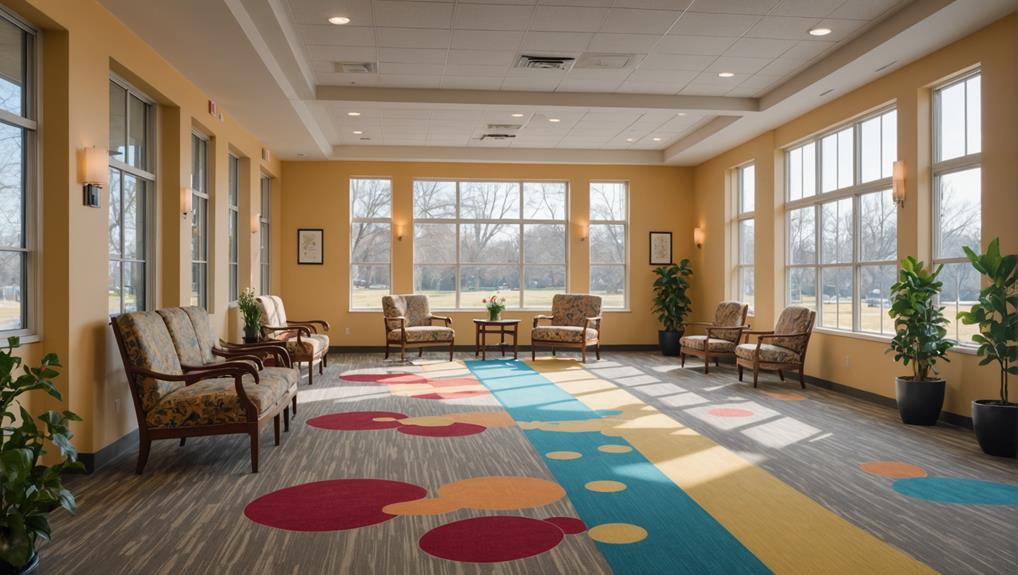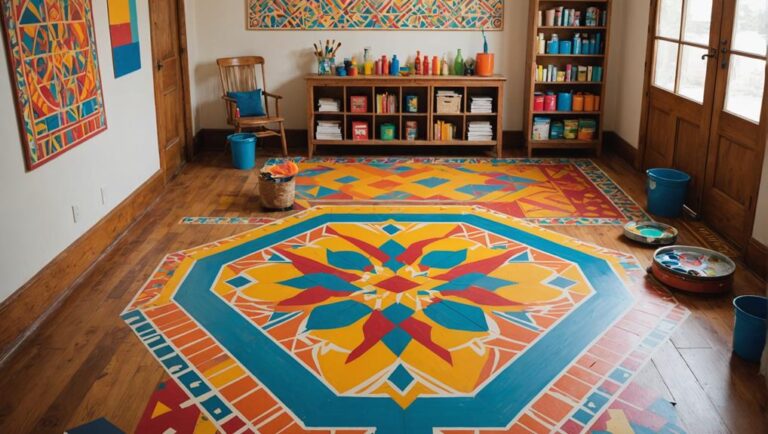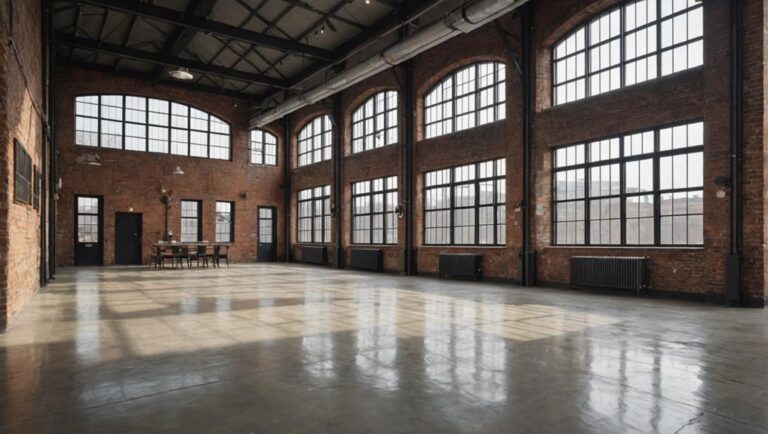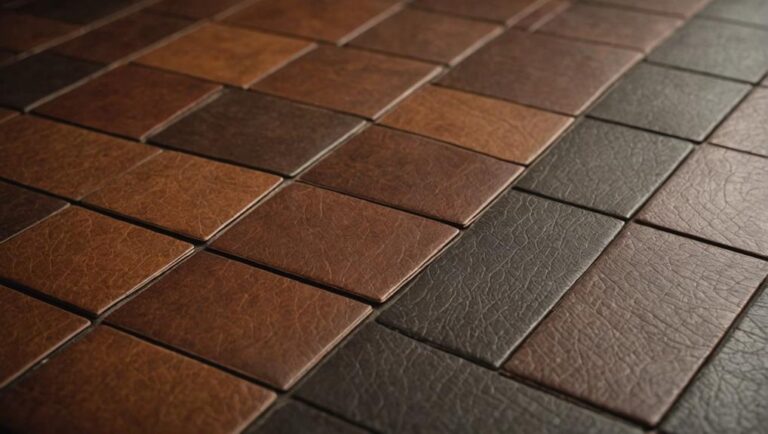When choosing anti-slip flooring for elderly care centers, you're making a vital decision to enhance safety and reduce the risk of falls. Consider options like textured vinyl, rubber, or anti-slip ceramic tiles, all designed to improve grip and comfort. These flooring types not only promote mobility but also build residents' confidence while walking. Regular maintenance is key to preserving their effectiveness and ensuring safety over time. Investing in high-quality flooring can also lead to long-term savings by minimizing injuries and lowering insurance costs. Discovering more options and insights can help you make the best choice for your center.
Importance of Anti-Slip Flooring
When it comes to ensuring the safety of residents in elderly care centers, the significance of anti-slip flooring can't be overstated. Falls are a leading cause of injury among older adults, and implementing effective slip prevention measures can greatly reduce these incidents. By prioritizing anti-slip flooring, you're actively working to create a safer environment for those you care for.
Research shows that seniors often face mobility challenges, making them more susceptible to accidents. Anti-slip flooring not only enhances grip but also meets important safety standards that are crucial in elderly care settings. These standards are designed to protect residents from the dangers of slipping, which can lead to severe injuries, extended hospital stays, or even loss of independence.
Choosing the right anti-slip flooring involves understanding the specific needs of your residents. It's important to take into account factors like texture, material, and maintenance, as these elements can all impact the effectiveness of slip prevention. Inadequate flooring can lead to tragic consequences, affecting both the physical well-being of residents and the emotional peace of mind of their families.
Types of Anti-Slip Flooring
Selecting the right type of anti-slip flooring is a vital step in enhancing safety within elderly care centers. There are several types of anti-slip flooring options you can consider, each offering unique benefits tailored to your facility's specific needs.
One popular choice is textured vinyl flooring. This option features texture variations that help improve grip, reducing the risk of slips and falls. It's also available in a wide range of colors and patterns, allowing you to maintain design aesthetics while prioritizing safety.
Another viable option is rubber flooring. Its natural slip-resistant properties are particularly beneficial in high-traffic areas and wet zones, such as bathrooms. Rubber flooring also offers excellent shock absorption, which can reduce the impact if a fall does occur.
If you're looking for something more elegant, consider using anti-slip ceramic tiles. These tiles can provide a beautiful, classic look while incorporating texture variations to enhance grip. They're also easy to clean and maintain, making them a practical choice for care centers.
Lastly, consider carpet tiles with anti-slip backing. These offer warmth and comfort, and you can easily replace individual tiles if they become worn or damaged.
When choosing the right flooring, think about the specific environments within your center and the needs of your residents. Prioritizing safety doesn't mean sacrificing style; you can find anti-slip flooring solutions that blend both functionality and design aesthetics seamlessly.
Benefits for Elderly Residents
Anti-slip flooring can greatly enhance the safety and comfort of elderly residents in care centers. By providing a stable surface, these floors play an essential role in fall prevention, which is a significant concern for seniors. When you choose anti-slip flooring, you're not just opting for aesthetics; you're prioritizing the well-being and mobility enhancement of your loved ones.
Here's a quick overview of how anti-slip flooring benefits elderly residents:
| Benefit | Description |
|---|---|
| Fall Prevention | Reduces the risk of slips and falls, ensuring safety. |
| Mobility Enhancement | Provides a stable surface, promoting freedom of movement. |
| Comfort | Softens impact in case of a fall, minimizing injury. |
| Confidence | Increases residents' confidence when walking. |
| Easy Maintenance | Simplifies cleaning, helping to keep the environment safe. |
The peace of mind that comes with knowing your loved ones are in a safer environment is invaluable. When seniors feel secure, they're more likely to engage in activities that promote social interaction and physical health. Anti-slip flooring offers not just a functional solution but a comforting environment, allowing for independence without constant worry. By investing in this flooring, you're contributing to a safer and more supportive community for elderly residents, ensuring they can move freely and confidently in their surroundings.
Installation Considerations
When considering anti-slip flooring for elderly care centers, it's essential to think about the surface material you choose, as it can greatly impact safety and comfort. You'll also want to evaluate the various installation methodologies available to guarantee the best fit for your facility's needs. Finally, don't overlook the importance of maintenance and durability, as these factors will help sustain a safe environment for your residents over time.
Surface Material Selection
Choosing the right surface material for flooring in elderly care centers is essential for ensuring safety and comfort. When selecting materials, you'll want to focus on both texture evaluation and material comparison to find an anti-slip solution that meets your needs.
Consider these factors when evaluating surface materials:
- Slip Resistance: Materials with high coefficient of friction can greatly reduce the risk of falls.
- Cushioning: Look for options that provide a softer surface to minimize injury during falls.
- Maintenance: Choose materials that are easy to clean and resistant to stains, making upkeep simpler for staff.
- Aesthetic Appeal: A visually pleasing environment can enhance the overall atmosphere, making residents feel more at home.
Installation Methodology Options
After selecting the appropriate surface materials, the next step involves understanding the installation methodology options available for anti-slip flooring in elderly care centers. You'll want to choose a method that not only guarantees safety but also enhances the overall aesthetic.
One common approach is using adhesive techniques. Proper adhesion is vital to prevent any lifting or movement of the flooring, which can pose a significant risk to the elderly. Make sure to select high-quality adhesives specifically designed for the materials you're using.
Additionally, consider various flooring patterns during installation. Strategic placement can improve traction and visibility, making it easier for residents to navigate their environment safely. For example, diagonal patterns can create a more dynamic look while providing added grip.
It's also essential to confirm that the subfloor is properly prepared before installation. A smooth, clean surface will help the adhesive bond effectively, thereby prolonging the life of your flooring. By paying attention to these details, you can create a safe, inviting space that meets the unique needs of your residents.
Maintenance and Durability
Maintaining anti-slip flooring in elderly care centers is essential for guaranteeing safety and longevity. Regular upkeep not only preserves the flooring's surface textures but also prevents accidents that can lead to serious injuries. You'll want to establish a consistent maintenance routine to keep the floors in peak condition.
Here are a few key considerations:
- Regular cleaning procedures: Use appropriate cleaning solutions that won't damage the anti-slip properties. Avoid abrasive materials that could scratch the surface.
- Inspect for wear and tear: Routinely check for any damages or wear, especially in high-traffic areas. Addressing issues early can prevent larger problems down the line.
- Reapply anti-slip treatments: Depending on the material, you may need to reapply anti-slip coatings periodically to maintain effectiveness.
- Educate staff: Make sure your team understands the importance of proper flooring care and adheres to cleaning schedules to guarantee safety.
Maintenance and Care
Anti-slip flooring in elderly care centers requires regular maintenance to confirm safety and longevity. Keeping these floors in top condition is essential not just for aesthetics, but for guaranteeing that they remain effective in preventing slips and falls, which is a priority in any care environment. Regular cleaning is vital; dirt and grime can diminish the effectiveness of the anti-slip surface. Use appropriate cleaning agents that won't compromise its texture, as some harsh chemicals can erode the safety features you depend on.
It's also important to stay updated on flooring trends and innovations in anti-slip materials. As new products enter the market, you might find options that offer better durability or enhanced safety features, which can be beneficial for your facility. Regular inspections should be part of your maintenance routine; look for signs of wear or damage that could affect safety. If you notice any changes, be proactive in addressing them to comply with safety regulations.
Additionally, make sure to educate staff on the importance of maintaining these floors. They can help identify potential issues early on and confirm that cleaning procedures are followed correctly. Remember, the safety of your residents is paramount, and proper maintenance of anti-slip flooring is a significant step in safeguarding their well-being. By investing time and resources into this ongoing care, you're not just adhering to regulations but creating a safer, more secure environment for everyone.
Cost-Effectiveness and Budgeting
When considering anti-slip flooring for elderly care centers, it's important to weigh the initial installation costs against potential long-term savings. Investing in high-quality flooring can reduce maintenance expenses and minimize the risk of accidents, ultimately lowering insurance premiums. By budgeting wisely for these enhancements, you can not only create a safer environment but also protect your facility's financial health in the long run.
Initial Installation Expenses
In the domain of elderly care centers, understanding the initial installation expenses for anti-slip flooring is important for effective budgeting and long-term financial planning. It's imperative to prepare a budget breakdown to make certain that all costs are accounted for and managed appropriately.
Here are some key considerations for your initial expenses:
- Material Costs: Different types of anti-slip flooring materials come at varying prices; knowing what fits your budget is essential.
- Labor Expenses: Professional installation is often required, so factor in the costs of skilled labor to ensure a proper fit.
- Preparation Work: Depending on the current flooring, you may need to budget for removal and subfloor preparation.
- Installation Financing Options: Explore available financing options that can spread out your costs, making the initial investment more manageable.
Long-Term Maintenance Savings
How can investing in anti-slip flooring lead to long-term savings for elderly care centers? The answer lies in the combination of reduced maintenance costs and enhanced safety. When you prioritize preventive measures like anti-slip flooring, you're not just safeguarding residents; you're also adhering to safety standards that can minimize future expenses related to injuries.
Consider the following table that highlights the financial benefits of anti-slip flooring:
| Category | Initial Cost | Long-Term Savings |
|---|---|---|
| Injury Prevention | High | Significant |
| Maintenance Frequency | Low | Reduced |
| Compliance with Standards | Moderate | Avoid Fines |
Insurance and Liability Benefits
Investing in anti-slip flooring can greatly impact insurance and liability costs for elderly care centers. By enhancing safety, you're not only protecting your residents but also potentially lowering your insurance premiums. Insurance providers often consider risk assessment when determining liability coverage, so reducing slip and fall incidents can lead to significant savings.
Consider these benefits:
- Lower Insurance Premiums: Safer environments may qualify for discounts.
- Reduced Liability Claims: Fewer accidents lead to fewer claims filed against your facility.
- Enhanced Reputation: A commitment to safety can attract more families looking for care options.
- Peace of Mind: Knowing you've taken steps to protect your residents is invaluable.
Implementing anti-slip flooring demonstrates a proactive approach to risk assessment, making it clear that you're serious about safety. By addressing potential hazards before they become issues, you can create a more secure environment for both residents and staff. Ultimately, this investment not only safeguards your residents but also enhances the financial health of your facility, aligning with your budgeting goals while prioritizing the well-being of those in your care.
Frequently Asked Questions
How Often Should Anti-Slip Flooring Be Replaced in Care Centers?
When considering replacement frequency for flooring, it's important to follow maintenance guidelines specific to the material used. Generally, you should inspect anti-slip flooring every 1-2 years for wear and tear. If you notice significant signs of damage or reduced effectiveness, it's time to replace it. Keeping up with regular maintenance guarantees a safer environment, reducing the risk of slips and falls. Prioritizing safety can make a significant difference in overall well-being.
Are There Specific Anti-Slip Standards for Elderly Care Facilities?
Yes, there are specific anti-slip standards for elderly care facilities, focusing on regulatory compliance and safety guidelines. You'll want to guarantee that the flooring meets criteria set by organizations like the Americans with Disabilities Act (ADA) and other local regulations. These standards help minimize slip hazards, enhancing safety for residents. Staying updated on these guidelines is essential, as they reflect best practices in creating a secure environment for those in your care.
Can Anti-Slip Flooring Be Installed Over Existing Surfaces?
"Don't put all your eggs in one basket." When considering anti-slip flooring, yes, you can install it over existing surfaces, but you must address installation considerations first. Proper surface preparation is essential to guarantee the new flooring adheres well and performs effectively. This involves cleaning, leveling, and possibly repairing the underlying surface. Prioritizing these steps helps create a safer environment, reducing slip risks and enhancing overall safety for everyone involved.
What Is the Lifespan of Different Anti-Slip Flooring Types?
The lifespan of different flooring materials varies greatly. For instance, vinyl and rubber can last 10 to 20 years with proper maintenance practices, while tile might offer 20 to 30 years. It's important to evaluate factors like foot traffic and care routines, as these will impact durability. Regular cleaning and timely repairs can extend the life of your flooring, ensuring it remains a safe environment for everyone who uses it.
Is Anti-Slip Flooring Suitable for Outdoor Areas in Care Centers?
You might be surprised to learn that anti-slip flooring can indeed be suitable for outdoor areas. When considering outdoor safety, it's essential to select materials that can withstand weather conditions while providing reliable grip. Durable materials, such as textured rubber or coated concrete, offer excellent traction and longevity. This combination not only enhances safety but also guarantees that the flooring remains functional and effective over time, giving you peace of mind for outdoor activities.




